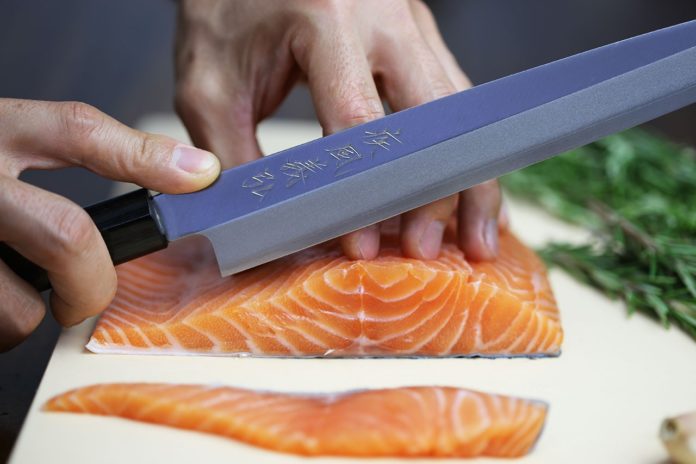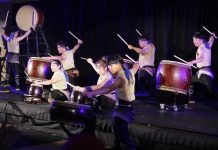
You’ve heard it before. “Japanese knives are the best.”
They’re sharp, artistic and get the job done (if you know what you are doing.)
So, how is it that you don’t know much about these fantastic pieces of steel besides the above? Ah, that’s right – nobody has told you. While there are scattered pieces of information around the web and some books that go deeper, we decided to provide a guide for newcomers to Japanese knives.
You know, lower the barrier to entry.
We here at The Nama (thenama.com), too, are learning more and more about these knives as time passes. And to go deeper, we’ve decided to write this guide to really break it down (selfish, right?)
Let’s get to the juice.
We will be discussing an overview of Japanese knives based on the chapters below:
- Design
- Cooking
- Buying Guide
- Maintenance
- Conclusion
1. Design
Why are Japanese knives so sharp?
The single-bevel knife is naturally sharper than a double-bevel knife because it allows one to cut with minimum damage to the texture of the food. With a double-ground blade, one would be putting pressure on both sides of the food. With the single-bevel, you can preserve the natural freshness and juiciness of the food by cutting on only one side.
Imagine cutting a tomato. Have you tried holding it and cutting only to find all of the juice spilt over the cutting board? The less pressure you put on it, the more juice it maintains, no? Using a sharp, single-bevel knife allows the food to preserve its umami, which is another category of taste that requires another blog post in and of itself.
The forging techniques also contribute to the extreme sharpness of Japanese knives.
There are two methods.
Honyaki, the traditional method, uses a process similar to forging Japanese swords to construct a knife completely of high-carbon steel.
The Awase method utilizes the benefits of high-carbon steel and soft iron. Awase can be translated as “bringing two things together.” The high-carbon steel forms a hard cutting edge, whereas the soft iron makes the spine strong and resistant to cracking and chipping.
What is the difference between Western and Japanese knives?
Western – double-beveled (sharpened on both sides of blade); usually made of softer steel, making the edge dull faster than Japanese knives.
Japanese – single-beveled (sharpened on one side of blade); usually made of harder steel, holds edge longer. Unlike Western knives, each knife must be used for their designated purpose to avoid chipping/cracking.
How are knives important to Japanese culinary or washoku?
Japanese knives were made to cut food into pieces small enough for chopsticks.
How are Japanese knives made?
The edge of a Japanese kitchen knife is made by hammering the blade from thick chunks of steel. Heating and hammering is repeated to harden the blade and help form its edge. During this process the steel is extremely elastic, allowing the master artisan to bring the shapes in his mind to the form within the fiery mineral. Through the process of annealing, quenching, and cooling, every step is painstakingly accounted for. A slight misstep could cause an imbalance of hardness and elasticity, which would make the knife to chip and crack. And nobody wants that. Not the artisans, not you or me, not the food.
For the awase method, blacksmiths beat the knife repeatedly to consistently drive out impurities in the steel while the two metals merge (high carbon steel and soft iron). At this point, the temperature of the hearth can reach 1400 C (2550 F).
Once the knife begins to take its true shape, the artisans coat the knife with clay to stabilize the temperature and help annealing occur, which hardens the steel.
After another round of heating, the awase blade is quenched in water, which further hardens the metal.
Then, the blade is reheated as part of a tempering process that gives the steel resilience and prevents brittleness.
The blade is then passed to another master that crafts the edge. Before this step, the blade is not sharp enough to cut tofu. This is where the edge crafter uses shaping and precise sharpening to create a cutting edge on the blade.
Creating the edge can be quite cumbersome. Between sharpening, polishing, and correcting distortions in the blade, there can be some 30 steps to the process.
Once sharpened into an actual knife to cut food, the blade is sent to yet another master that attaches the handle and collar. This handle can be made of ebony, honoki, mahogany, etc.
Before shipping, some shops do honba tsuke – which can be described as “creating a real edge”
Also, natural plant oils are rubbed on the blade before storing to prevent rusting.
Japanese knives of both the honyaki and awase variety are made of carbon steel so they rust easily. Considering this, please make sure to dry your knives immediately after washing. We recommend you wash immediately after using as well. You don’t want to spend a premium on a knife only to damage it by mishandling and neglect. Think of your knives as your kids – would you leave them outside of the house dirty and alone? (don’t answer that)
(Japanese Kitchen Knives)
2. Cooking
“To cut is to cook.” Or at least so says the ancient Shinto gods of Japan. (not really)
The way you cut your food determines which elements are kept or not in the food. The texture also changes radically.
Japan as a whole is a combination of modern and traditional elements. You see it in Tokyo, Kyoto, Fukuoka, Hokkaido, everywhere. Overall, the atmosphere and mood of the country is one of elegance and simplicity.
This also translates to the way Japanese view food. Largely, the mindset and attitude towards food in Japan is one of reverence. There is almost a religion of sorts to the act of preparing, cooking, displaying and eating food. Which probably explains why washoku won the Intangible Cultural Heritage of Humanity Award from UNESCO. Not a particular dish. The entire category of Japanese food. That’s beyond words.
The reason food is so highly regarded in Japan is largely influenced by Buddhist and Shinto sensitivities. In a country where food is presented to the shrines and graves of the deceased, one can easily begin to see the whole picture.
Culture and societal behavior have a synergistic relationship. In other words, culture influences the way people behave and think in society, and inversely, behavior affects and develops culture. (Culture and Psychology). This relationship fuels the approach to washoku, as much as oxygen enriches our cells.
Now that we understand the affinity to nature and the respect for food that is prominent in Japan, we can talk about how this relates to knives. (finally)
So, if you’ve ever been to an authentic Japanese restaurant in your country or in Japan, you will notice how many different dishes are used to serve the food.
You will see an assortment of vegetable, rice, soups, fish and meats laid out in a variety of different dishes. Depending on where you are, these dishes will be displayed with their own unique presentation.
There are a number of different opinions out there, but from my experience in Japan, I often heard that the food loses its taste if it isn’t prepared with kokoro. This “heart” can be seen not only in the love and effort expended to make the food beautiful and tasty, but in almost every other discipline in Japan. Devotion and dedication to craft. Also, as with objects such as art, our brain determines the value of an object based on its appearance. This is why ugly fruits and vegetables get a bad wrap in the suoermarket. (Scientific American)
It’s like people you aren’t attracted to physically. You might get a bad taste in your mouth before they even start talking. No matter how they are as a person, you already have a negative association in your mind.
This is why we should do our best to dispel any preconceptions we have before trying something new. We color the experience before ever trying. You might find your taste buds glimmering with joy despite the appearance of the food.
Despite the fact that poorly prepared food can taste good, the Japanese don’t play that. They treat the presentation just as important as the taste. This probably explains why their restaurants have the most Michelin stars of any other country. Sorry France.
OK, so the purpose of chef knives in a Japanese kitchen are to cut food into pieces small enough for chopsticks to hold.
We have already established why they are sharp (see section 1). It is this sharpness that is used to reduce the damage done to the tissue of the food leaving it in pristine condition, umami and everything.
Next. How do you use the damn things?
Cutting Posture
Much like martial arts, there is a certain posture that helps one cut. The ultimate transfer of energy through the knife to the food. The following position helps one maximize the use of one’s energy and keeps your focus on the food and your materials.
Spread feet shoulder width apart, bring right foot back, turn right foot out 45 degrees, lock right arm to ribcage shutting down the armpit for the day, and curve the left arm across the body inwards so you look like the half moon itself.
Then, as always claw-it-up. We don’t need any chopped fingers, because remember Japanese knives are unbelievably sharp. Some of my Japanese friends have told me of instances where they cut deeply into the cutting board. (can you believe it? Dropping premium on a knife only to go to the dollar store for the cutting board. Despicable.)
So, make sure to put your index, middle and all the other finger knuckles against the side of the knife while you cut, which is known as the “claw.”
Personally, I find it helpful to watch your breathing as you cut. Like meditation. It helps you not only concentrate, but you begin to really enjoy the preparation process for its own sake. Not just a necessary step to getting the grub into your gut.
Great. So you have the mindset and posture necessary to make food with kokoro. Now let’s get you a suitable Japanese knife.
3. Buying Guide
How do I decide on a which Japanese knife I need?
A healthy dose of self-awareness. First ask yourself, for what purpose do you need a knife.
In other words, what will you be cooking? Will you be cooking Japanese food? Or you just want a solid, sharp knife that will last you years?
Generally, the three main types of Japanese knives can be broken down into these categories:
usuba, deba, yanagiba
What is an Usuba knife?
An usuba knife is mainly used to cut vegetables. The blade is thin and broad and when cutting, the weight of the knife is used to cut. There is also a style of cutting called utsu, where you cut straight down parallel to the board and move across to the far side of the cutting board.
Variety of different knives: Nakiri and Santoku.
Types of food you can prepare with the usuba knife:
Each section of the knife is used for a different type of cut —
Katsuramaki – this style of cut is used to cut a thin sheet from a cylindrical vegetable. Usually daikon. Use your right thumb to hold the knife while using your left hand to rotate the vegetable. You cut on the upstroke. Bringing the knife down returns you to your original position.
Depending on the pressure of the thumb, the sheet will become thinner or thicker. The more pressure = thinner sheet.
Sasagaki – This cut is used to essentially “shave” long vegetables like gobo (burdock root). After brushing and washing the dirt off the burdock root, lay it horizontally on the cutting board. Cut off the ends. Make shallow cuts along the length, so that when you cut, the shavings slide. Now using your left hand to rotate it back and forth, place the knife edge away from you towards the end of the root. Using swift movements as you roll the root back and forth, get to shaving. You can determine the thickness of your root depending on the angle and pressure you maintain.
*Fun fact: my ex-girlfriend used to call me this because of how skinny I was…how inconsiderate of her.
What is a Deba knife?
This blade is used for fish bones, meat, and other generally hard materials. Like the usuba, the weight is used to cut.
Because of its wide spine, you can use your left hand to support when cutting stubborn materials.
Types of food you can prepare with the deba knife: Fillet fish. Ever see those fish spread wide open on sticks? If you have ever walked through a Japanese supermarket, you will see these fish in the refrigerated section. The style is called hiraki, which is essentially “butterflying”. This spread allows the fish to dry efficiently.
Ever prepare a crab from scratch? Most haven’t, but with the deba, your life becomes much easier. The shell of these crawlers don’t hold a light to the deba and your cutting posture.
What is a yanagiba knife?
This long samurai sword cousin is dedicated to cutting sashimi. As is often said in Japan, sashimi wo hiku or “sashimi is cut by long, pulling motions”.
Types of food you can prepare with the yanagiba or sashimi knife: there are two primary cuts that can be made with sashimi– sogizukuri & hirazukuri
Sogizukuri – the fish is sliced very thin. This cut is common for most types of sushi.
Hirazukuri – this cut is perfect for fatty fish like tuna. Cut into thick slices to deliver a satisfying mouthful.
What is a santoku knife?
The “three-purpose” knife is essentially an all-around knife that is often found in Japanese homes. Unlike the typical usuba, the tip is curved. It is usually used for vegetables and small pieces of meat. Because of its wide range, it has become popular over the years.
4. Maintenance
How do I sharpen a Japanese kitchen knife?
Both natural and synthetic stones are used to sharpen Japanese kitchen knives, but the former is becoming increasingly rare to find in Japan. Considering this, synthetic stones are more commonly used in the kitchen to sharpen knives for everyday use.
We have access to natural whetstones from Japan. To inquire, please get in touch here.
The stones are measured by grit size from 80 to 8000 grit denoted by the symbol, #. To measure the grit of these stones, the abrasive grains are passed through a sieve. The amount of holes in the sieve within a one-inch square corresponds to the grit.
A #600 grit stone is made up of stones that passed through a 600-hole-per-inch sieve. The higher the grit, the more holes you have per inch. Essentially smaller holes make the grit much finer.
After time, the stone itself will become uneven. You can use what is called a “fixer stone”, which is harder than the typical whetstone. Place it on top of the whetstone and rub it back and forth until you smooth it out. When the stones meet evenly against each other, you’ll know you’re finished.
For sharpening, we recommend going to this blog post for the most thorough instruction. This shop owner specializes in sharpening Japanese kitchen knives, so you are in good hands. (get it?)
To cover the basics:
- Soak stone in water for at least 30 minutes and wet the stone during the process. Dry stone will destroy your knife’s edge. The residue from the stone, called toguso, will appear. Don’t wash this away, as it aids the sharpening process.
- Arc the knife 15 degrees or the height of two coins (10 yen or nickels should do) against the stone.
- The process of sharpening is basically forming and removing the kaeri – which is the long burr towards the back of the knife.
What sharpening stones should I purchase?
There are typically three grades of whetstones available:
Arato (coarse stone) # 80 – 220
Nakato (fine stone) – fine “no pun intended” for home cooking #400 – 1500
Shiageto (finishing or extra fine stone) – more than #3000
How to clean Japanese knives?
As mentioned before, we recommend washing and drying as soon as you are finished using the knives. Especially if you are cutting something acidic. Keeping a damp cloth near you when cutting is a good idea.
Using hot water to wash, helps with air-drying afterwards. Wipe and air-dry. Before sharpening, make sure to clear off any stubborn stains. You can use a cork or daikon skin with a powdered cleanser to get them off. Be careful of cutting your finger when rubbing these stains off.
Conclusion
We’ve discussed what makes Japanese knives bring out the best in your food. Before walking into this guide, you might have come with some previous knowledge or none at all. I hope I have provided enough here today for you to approach your food, kitchen and your tools differently.
To recap –
- Japanese knives are born from the history and mindset of Japanese food or
- When choosing a knife, you must think not only about your budget and purpose, but also your available time and energy to take care of these knives.
- Also use a knife for its designated use, i.e. don’t use a yanagiba to cut crab.
Writing this guide has reminded me of the importance of food in our lives. Our liveliest and most important talks often take place around a table of food. Just as we want to feed the people most important to us with bountiful feasts, we must approach the food with the same mindset when preparing and cooking.
***
Sources
Nozaki, H. and Klippensteen, K. (2012). Japanese Kitchen Knives: Essential techniques and Recipes. Kodansha USA.
Matsumoto, D. and Juang L. (2016) Culture and Psychology 6th ed. Cengage Learning.
The Neuroscience of Beauty / Scientificamerican.com











